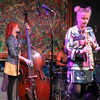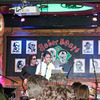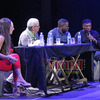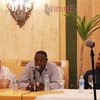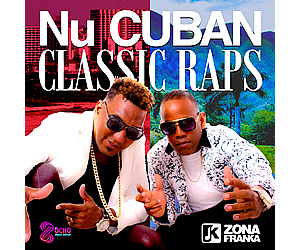Indice - Table of contents
New Stuff[hide]
Reportes: From The St... : Jazz Plaza ...
Fotos: Tom Ehrlich : Irakere 50th Annivers...
Fotos: Tom Ehrlich : Irakere
Resenas: Joey Altruda Presents: El Gran ...
Reportes: From The St... : Cubadisco 2...
Timbapedia: 09. Interviews -... : Carlos del Pino ...
Fotos: Tom Ehrlich : 2023 Monterey Jazz Fe...
Fotos: Tom Ehrlich : 2023 Monterey Jazz Fe...
Fotos: Tom Ehrlich : 2023 Monterey Jazz Fe...
Fotos: Tom Ehrlich : 2023 Monterey Jazz Fe...
Grupos: Tirso Duarte
Grupos: Tirso Duarte : Discography
Grupos: Charanga Habaner... : 8. El bla bla bla
Grupos: Pupy y los que S... : Tirso Duarte
Photos of the Day [hide]
SpanishEnglishEntrevista con Enrique Lazaga - Page 9
--What do you remember about the recording of that album and that period in the group’s history?
I think we recorded that record…that was the last LP we made, I think we made it in Santiago de Cuba, in the Siboney studios. That was the end really… We could have kept on producing but… By 1987, 1988, 1990 new things were bursting onto the scene. The first to emerge was salsa and then came the metales, then this and that…that’s how it was.
Tell us about Baila si vas a bailar? How did you come up with that song and what do you remember about arranging it, recording it, playing it live, etc.
Yeah, that is one of mine, it’s a jam. Look, whenever you are going to record, whenever you are making a record, I don’t know if the same thing happens nowadays, but look, I recorded a CD with Frank Emilio and the same thing happened. Whenever you are going to record, you always have either time to fill or you need one more song. So it was a jam. Just look at what I called it, Baila si vas a bailar (Dance if you are going to dance). Because they told me, ‘Lazaga, we need a song to fill in the time, we only have 50 or 45 minutes’ So I told them, ‘Alright, ok, let’s go.’ And so I sat down for a second on the piano and made up a tumbao and said, ‘Ok, you play this and you this and…” It was arranged right then and there.
--And recorded at that moment…
Yeah, of course. Those are the best recordings. Look, we made a record, Changuito, Tata Güines and I with Frank Emilio, we were short a tune, so Frank Emilio called us together and said, “Look, I’m going to play this, you do this, Lazaga you begin with a güiro solo, than Changuito, in three, and I’ll play this on the piano…and we’ll see what happens! The guy left and when we said, ‘Ok were ready, let’s start recording, the businessman, who was an American, and the sound engineer, John Fauten, one of the best in the world, said, ‘No, we already recorded it.’ Because that was not going to come out the same again, you know what I mean? Because what is done spontaneously, to do it over again, you do something different, that could turn out better, but that could also turn out worse, you know what I mean. But when it comes out good…And that’s what happened with Baila si vas a bailar. It was a jam, I said, ‘Look you play a paila solo there and I will do this here…and a song was born.
--And it was a song you played a lot live?
Yes, it was.
--We talked a bit about another popular song, Tony Cala’s El baile del azúcar, with its famous bass tumbao and the coro that people around the world copy —a la derecha, a la izquierda— in fact I heard that coro in a new American pop song just the other day; tell us about that song and the coro.
Yes, today lots of groups still use that coro, I was in Mexico and there are bands there that used the a la derecha a la izquierda part, that try to teach the audience the dance. It is something that makes me proud, something that lasted…
-- The last album with Tony Calá seems to have been recorded on the Siboney label. It had Baila azúcar, Ana Margarita, Advertencia a todos, No hay regreso
No hay regreso that is also one of mine. Yes that was recorded in the Siboney studios.
--Can you tell us about how Tony Calá left the band to go and play with NG La Banda?
Well, how can I explain it to you? When someone gives you something, you sometimes cherish it and sometimes you don’t, but when you have to work to get something you really cherish it. I’m not saying that Tony Calá didn’t cherish La Ritmo Oriental, he did cherish it, because he made it with la Ritmo, he became a singer there. But Tony Calá joined La Ritmo Oriental in its last stage, when it was all ready an established band. Those of us who were in the band, loved the band, and he loved it too. But all musicians want to keep rising and looking for new things, and when NG formed, with Tosco, Germán Velazco, people who came from Irakere, guys who were famous musicians; they came and spoke with him and he went and joined them. And also, even today, Tony Calá is still a young man, at that time he was a very young man, and when someone goes out looking for a singer…and so I told him, ‘Yes, chico, go ahead, go over there.”
-- In La Ritmo, Tony Calá sang, played violin and wrote some good songs.
Yes, he did. He wrote his songs and played his violin, but afterwards he just sang and nothing else.
With NG La Banda, he stopped writing and started to have health problems. Had those problems already begun when he was with la Ritmo?
Yes, he had health problems, but, anyways, he is still with NG. He has only played with two groups in his life, La Ritmo Oriental and NG.
--The last album before the 1990s with Popurrit de éxitos, La gioconda, Treinta años, Azúcar con chocolate, Pasen señores; what can you tell us about it.
Nothing…That was just one of those records that were made, one of those things that were made and nothing happened. There were a few songs that were played on the radio but nothing really relevant happened with them, you know what I mean?
-When you recorded the early albums at EGREM you told me you used four tracks…
Well, yes. The first records that we made, but we made 45s without just one track such as Viva la libertad and La sabia naturaleza that was the first record we made. But afterwards came the multi tracks.
--And how did they do the mixes? What were the different tracks you would record?
Well, today it is harder but also easier, because before there was the rhythm track with the bass, then there was the chord track, the flute track and the vocals track, there were four tracks. Now there are more than 30 tracks. There is the conga track, the guiro track, the paila track, so you just stack them all up until you have a balance, a sonorous equilibrium, until you get what you want. It is the most important part of the process. Multi tracks are a great technological advance, but when everyone records together it is better…if you make a mistake, you lay it down on top, afterwards. Because everybody likes to hear everybody together. When you don’t hear anybody, you say, “Damn it, am I wrong?”
--People complain that the timbales are hard to hear on the early EGREM recordings.
Remember we lacked good recording engineers. For example, there was an engineer who worked in Radio Progreso, Medardo Montero, who was very good, but then he quit recording and became the director of EGREM. There was another very good engineer, who was not a professional engineer but worked a lot around recordings, his name was Mariano Suárez del Villar. But the problem with recording is that, independent of personal taste…remember that sound engineers around the world are individuals who study music, who study a whole series of things. Here the sound engineers didn’t know anything about music.
It’s like when you are watching a baseball game on TV here and the ball goes to third base and the cameraman shoots first. And baseball is our national sport and everybody knows it. Sometimes I’m watching a TV program where there is an orchestra, the Symphonic Orchestra or something like that, and the soloist is a trumpet player, but they show the hands of the pianist. Even if they are good, their level has to increase…
You have to study; unfortunately or fortunately, people need to study. He who doesn’t study is dead, as we say here. Fidel once said that geniuses are born but they need to be taught technique. That’s true. That’s why when you get… Look, there are sound engineers such as Frank Bejerano and Vertico, who are musicians, and when you hear recordings by them, wow… That’s why when they are going to do the mix, the director of the orchestra also has to be there because he is the one who… he is the musician, the one who says, ‘Bring the guiro up here, lower the bell there, raise the violins here.’ When the sound engineer is also a musician, the director goes to supervise, but it is the engineer who has to know what’s going on. In addition, it’s important that the engineer, the mixers, are all familiar with the different formats and genres of Cuban music. A charanga isn’t the same as a timba group, or a conjunto. There is a whole series of elements and factors that influence on achieving a favorable result in a mix.
--What can you tell us about Juan Claro, was he always blind or did he go blind later in life?
He became blind. He should be calling me soon.
--Was it Juan Claro who invented the tumbaos so characteristic on tunes like Se baila así and Son de Claro and so many others?
Yes, he created all those tumbaos, just like Daniel did on the pailas, all those things he did were his own creation.
--But where did these tumbaos come from? There seems to be influences from bongos and congas.
Look, the origin of those types of tumbaos is nothing more or less than the desire to push the envelope to look for new frontiers. The charanga is a weak and small musical format because violins are not the same as trumpets and saxophones… Even Daniel, who has passed away, graduated as a kit drummer and I told him, ‘Take everything that you studied in school, everything you have learned, and apply this to the charanga format; not with the drum set, because if you do…’ Although today, the charangas do have drum kits. So, he created a series of tortones, with a bell in the floor. At the time, charangas played with only one conga player, so Claro picked up the congas and I told him, ‘Claro try to do something like batá, like a bongo…’ and that’s how we started, you know what I mean? Those were the kind of musical drives we had.
--Humberto Perera was another of the bands incredible musicians who seems to have developed a unique style that opened up new possibilities on the bass. What were his influences?
He was another guy who created, developed a style in the way charangas played bass.
--What were his inspirations in creating this new style?
Look, the thing is that he studied cello and then he studied double bass at the ENA (National School of Arts) as a young man. At the time he was working with the Contemporary Music Orchestra of Matanzas, Idá Rabá, and came to the ICRT (Cuban Institute of Radio and Television) as a cello player. One day we had a problem with the bass player and he told me, “Look, I... “ And he joined the Ritmo Oriental as a cello player, but we had problems with the bass player and so he took up the bass. Humberto created a new style in the way charangas played the bass. He was terrible [incredible], a terrible bass player!
I’m telling you a whole series of factors all came together at the same time in the Ritmo OrientaI making it like the Storm of the Century. A series of elements all came together to make something almost perfect. And I am not saying that we were perfect or that we were the best or anything like that, but one thing that is for sure is the rhythm we had…no one could outdo it. Our flautist was no Richard, but he was no less than Richard. In my opinion, Richard is the best Cuban flautist in popular music, but our flautist was also very good. Our signers were good signers. Our violin players were good violin players. And our bass player was a good bass player, a bassist who… And our piano player was a good pianist. You know what I mean? A series of factors all came together, as happened during the storm of the century, making something perfect.
--The breaks during the arrangements are often not played at the same tempo as the body of the tune. Many Cuban bands used similar effects of tempo variation in the breaks. Was there an originator of this style or did it arise from particular types of music?
Chico, the question of what emerges or doesn’t emerge in a piece, in a song is something determined by the moment when you are playing, by the performance at that precise moment. The breaks were something you put in to differentiate yourself from the rest and a series of things. Besides, there are breaks or bloques that you have been playing at a certain aire [rhythm] that if you continue playing them at that same aire they come out sounding rushed. So, this makes you think that you have to rework them a bit more so that they come out musical, so that they work out, and then you go back to your first aire. That’s what happens, you are coming in on a certain aire and you go to do something else and you realize that it is going to sound rushed, so you go back to the beginning to redevelop it a bit more and you go back and pick it up again. Those are things that come from the heart, as we say, de la cuchara, de la cuchara.










